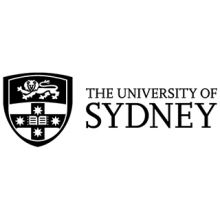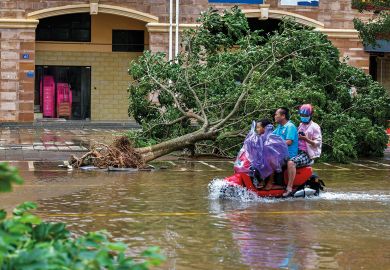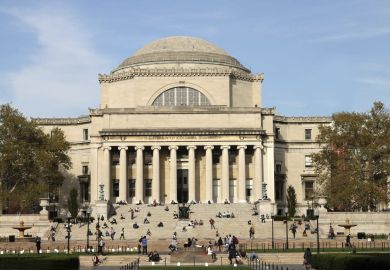As Covid-related border restrictions finally recede into history, the world's international education destination countries are wondering how to reinvigorate overseas student flows and shepherd them in the desired direction.
Measures to speed up visa processing, conjure cheaper and more reliable flights and improve students’ experiences abroad are all part of the answer. But as each nation looks over its shoulder at its competitors’ tactics, work and migration rights come to the fore – and nowhere more than in Australia.
Pound for pound, Australia has long been the world champion of marketised international education, cultivating an export industry netting over a billion dollars (nearly £600 million) by 1992. In 2019, after the industry accelerated in the early 2000s and again from 2014, some universities achieved billion-dollar-plus export earnings in their own right.
THE Campus resource: How to support international students’ journey through higher education
Some recruited from abroad so eagerly that they were admitting more new foreigners than locals, with the international component of enrolments at some institutions creeping towards 50 per cent. Foreign students funded a wave of frenetic campus building and underwrote the outsized salaries of the star academics who helped keep Australian universities riding high in international league tables.
But the wheels were wobbling long before Covid-19 closed borders and brought the flow of foreign students to a grinding halt. In the early 2000s, severe acute respiratory syndrome (Sars) triggered a decline in enrolments from Asia. Then, towards the end of the decade, a cocktail of factors – a high Australian dollar, visa changes, crackdowns on dodgy colleges and brutal street attacks against Indian students – precipitated a plunge in student arrivals that took years to reverse.
These setbacks mostly affected vocational and English language colleges. But half a decade ago, concerns began surfacing about universities’ international activities. The anxiety mostly centred around their reliance on students from China, who by 2018 supplied some universities with more than one-quarter of their revenue.
Educators worried that any number of eventualities – currency restrictions, exchange rate fluctuations, foreign competition, efforts by Beijing to shepherd students elsewhere – could suppress this trade or even stop it in its tracks, pulling the rug out from under the fiscal feet of some of Australia’s most highly rated universities.
Covid has shown that such concerns were warranted. The impact of border closure on universities’ finances has been relatively muted, costing the sector perhaps A$2.3 billion (£1.3 billion) or 6 per cent of their revenue in 2020, compared with what they might have pocketed if international education earnings had continued to grow at pre-pandemic levels. But fears of financial catastrophe panicked universities into jettisoning something like 26,000 of their staff.
And despite the resumption of international travel, the worst may lie ahead. Universities’ foreign enrolments could remain depressed for years as a flat patch between March 2020 and December 2021, when almost no new overseas students arrived, works its way through the system. And the long-term impacts of factors that emerged during the pandemic – particularly a newfound trust in online education and reputational damage due to the Morrison government’s unsympathetic treatment of international students – remain to be seen.
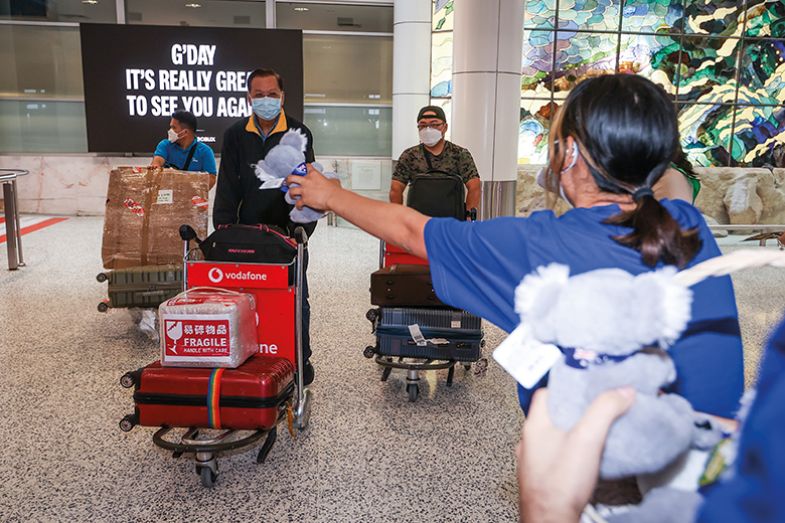
In Australia, international education was often sold to sceptical locals on its national economic benefits, which exceeded A$41 billion in its pre-Covid heyday. The beneficiaries were not only universities and colleges but also local enterprises and family businesses, such as restaurants, corner stores and accommodation providers. And as Covid trashed the Australian workforce, international education became valued as a supplier of employees – from supermarket stockers, farmhands and baristas to nurses, aged carers and, eventually, pretty much every other profession.
“There are more jobs now available in Australia than before the Covid-19 pandemic,” then immigration minister Alex Hawke said in a February media release celebrating the return of young foreigners. “There are still many more places available to backpackers and students that we are ready to fill, so come on down.”
The change of government in May ushered in a new mindset, with Labor education minister Jason Clare announcing that he wanted students to come for the long haul. “There is more we can do to get more students that we teach and train here in Australia to stay here and work long after they finish their studies [and] help us fill some of those chronic skills gaps in our economy,” he told the Universities Australia conference in July. “At the moment only 16 per cent of our international students do that. In some of the countries that we compete with for talent, it’s a lot higher than that.”
Clare highlighted this as a topic for the fledgling government’s signature Jobs and Skills Summit in early September. But instead of producing mechanisms to boost permanent migration by international graduates, as he had suggested, the summit resolved to increase the time-capped periods that graduates are allowed to stay and work after finishing their studies.
The government proposes a two-year boost to post-study work rights (PSWR), which are already generous by international standards, for graduates of “select degrees in areas of verified skill shortages”.
This will lengthen the periods that former bachelor’s, master’s and PhD students can stay and work to four, five and six years respectively. Some graduates also attract extra work rights for studying and working in regional Australia. An expert group will be appointed to advise on the summit proposal and report in late October.
Clare ticked the announcements off as a win. “This will mean they can stay on longer and use the skills they’ve gained in Australia to help fill some of the chronic skills shortages we have right now,” he said after the summit.

Graduate work rights have long featured in anglophone countries’ competitive efforts to attract international students. When then UK home secretary Theresa May abolished automatic PSWR for non-European graduates in 2012, for instance, Australia was ready to pounce. Canberra introduced clearly defined post-study visas of between two and four years from 2013, partly to compensate the sector for dismantling migration pathways for foreign students between 2007 and 2010.
When UK universities minister Jo Johnson reintroduced two years of post-study visas in 2019, the UK won back some of the student traffic it had lost to Australia over the previous seven years. But Australia pounced again two years later, boosting work rights for foreign graduates of vocational courses, taught master’s degrees and at regional universities. Depending on their nationality, level of qualification and location of study and work, foreign students in Australia currently qualify for PSWR of up to five years – the longest of any of the major education destinations.
Janet Ilieva, founding director of Bristol-based consultancy Education Insight, says the combination of globally recognised qualifications and overseas work experience is a “powerful proposition” for internationally mobile students – and, consequently, for the Covid-depleted destination countries seeking their custom.
“Economic downturns are affecting most of the world economies, and the increasing cost of living is pushing students to carefully consider their study options,” says Ilieva, formerly an analyst and economist with the British Council and the Higher Education Funding Council for England. “Value-seeking students are likely to weigh the pros and cons of each study destination.”
Fellow former British Council analyst Anna Esaki-Smith agrees that the ability for students to work overseas after graduating is a “huge draw” since overseas work experience can “give them an edge” when they seek employment back home. But this applies more in some countries than others, notes Esaki-Smith, co-founder of New York-based consultancy Education Rethink. “Universities cannot count on PSWR as a selling point for all international students.”
It is not just anglophone countries that value international students. Futao Huang, a professor at Hiroshima University’s Research Institute for Higher Education, says foreign students are in high demand in Japan, too. The country looks to them to provide “critical skills”, particularly in STEM fields, and to bankroll the private universities that accommodate almost 80 per cent of Japan’s students. “Most of their operations rely on tuition fees,” he says.
Esaki-Smith says countries with ageing populations, such as Japan, South Korea and Italy, are also looking to foreign students for demographic renewal. And employers everywhere are looking abroad to “build competitive workforces”.
She says the most significant battle for global talent is being waged between the US and China for expertise in artificial intelligence and machine learning. “Technology will determine the future direction of economies and societies, so the country that can draw top-tier tech visionaries will wield considerable influence in how the world evolves,” she says.
China has the advantage of “sheer human capital”, but US universities have some of the world’s best engineering and computer science programmes, Esaki-Smith says. The country that can most successfully educate its own students while integrating international graduates into its workforce “will come out on top in this high-stakes competition”.
The battle for skills is also intensifying elsewhere. In the UK, Brexit has exacerbated Covid’s impact on skill availability, pushing job vacancies to an all-time high. Ilieva cites an Office for National Statistics estimate of 1.3 million unfilled jobs between March and May – over half a million more than before the pandemic – although vacancies declined slightly over the following quarter.
But while skill shortages are influencing countries’ policies on post-study visas, background political factors also have considerable sway. In January, when the Biden administration boosted the number of STEM disciplines in which foreign students qualified for an extra two years’ PSWR – over and above the 12 months available to graduates of non-STEM fields – it was responding to competition with China, particularly in environmental and data science. But the move was also part of a broader rollback of Donald Trump’s immigration policies.
And when New Zealand moved in the opposite direction in May, scrapping PSWR for some vocational students and limiting foreign university graduates to one post-study work visa even if they do a second degree, Wellington said the changes had been necessary to combat visa scams. But some observers believe the new rules were primarily aimed at mollifying public concerns that foreign students were exacerbating a housing squeeze, particularly in Auckland.
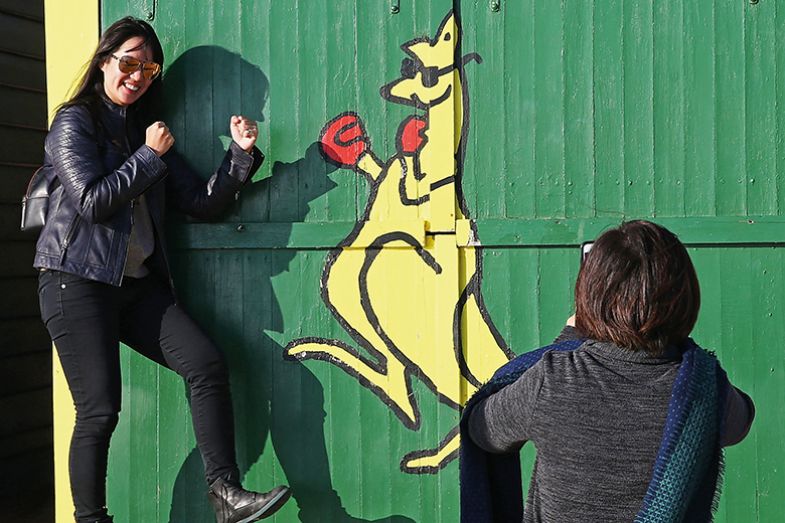
Within international education, the bigger concern is that post-study work visas do not benefit students as much as they should. Ilieva says PSWR imposes a “huge responsibility” on host countries and institutions to furnish foreign students with meaningful internships and work experience.
Jonathan Chew, head of insights and analytics with global education company Navitas, says Australia has maintained the lead in a “bidding war” over PSWR. But such efforts are “hitting the point of diminishing marginal returns” now that graduates can stay on and work for up to six years – longer than many employers might reasonably expect from domestic job applicants.
“We can keep tacking on a year for this and a year for that, but at some point we need to turn our minds to not just the quantity but the quality of the experience,” Chew says. Research has shown that relatively few overseas students are securing good graduate positions in the fields for which they trained, with large proportions “stuck in what you might call their university jobs” of hospitality, retail and warehousing.
Chew says foreign graduates are a “huge untapped source of skilled labour. It feels to me like it’s the best-kept secret. We’re often tapping international students on the shoulder for different jobs and roles at our colleges.” He says his team recently engaged an Iranian doctoral graduate in data analytics. “If we’re lucky we’ll get him for five years, which is phenomenal.”
But many other employers are dubious of graduates’ English language skills or local knowledge, or they are deterred by the perceived bureaucratic headaches involved in employing foreigners.
Chew says it is not enough to merely educate bosses about the potential benefits of enlisting overseas graduates. He advocates consideration of direct “incentives” for employing them – an approach used for years in vocational training, with Canberra currently subsidising apprentices’ wages by up to 10 per cent and paying bosses A$3,500 “hiring incentives” for signing them up.
However, Phil Honeywood, a former Victorian tertiary education minister, doubts that any such scheme targeting international graduates would be “politically saleable” because it would be framed as the government paying bosses to hire foreigners over locals. Honeywood, now CEO of the International Education Association of Australia, instead advocates migration-related incentives, backed at both federal and state government levels to dissipate the “political pain”.
He cites South Australia’s policy to grant “state nomination” to most foreign graduates who have lived in the province for at least seven years, supplying them with five of the 65 “points” needed to qualify for permanent residency. Graduates of South Australian universities already pocket an extra five points, because Adelaide – unlike Brisbane, Melbourne or Sydney – is deemed “regional” for immigration purposes.
Honeywood also advocates a doubling of the five points available to graduates who have completed “professional year programmes” (which refine students’ employability skills) and organisation field placements. “It gives them a taste of work in the [discipline] they’ve graduated in, and it provides Australian employers with a potentially good international employee,” he says.
Some experts worry that boosted migration incentives could add to the pool of foreigners jumping from one temporary visa to the next, as they harbour unrealistic ambitions of securing permission to stay for good. Such people are “unwilling or unable to return, but unable to find a pathway to permanent residence”, former immigration department deputy secretary Abul Rizvi told the ABC. “We’ve got to fix those pathways so that we don’t leave so many people in immigration limbo. That is the type of thing that happens in the US; it happens in Europe; and we should avoid it.”
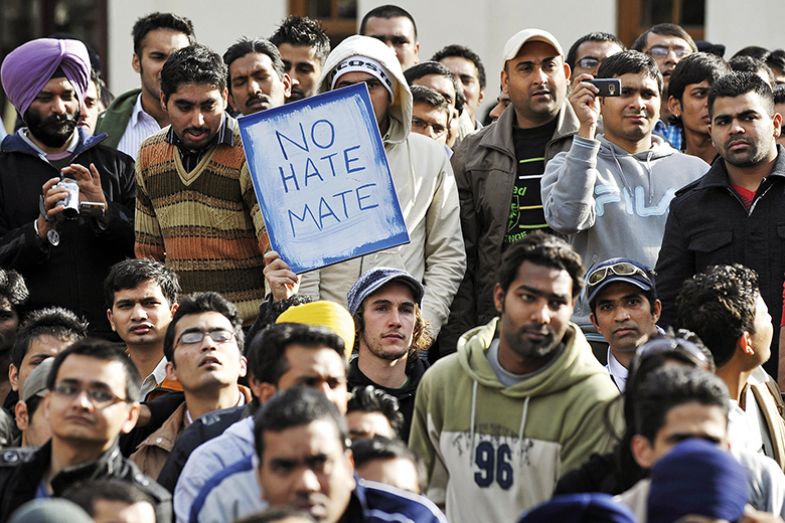
While Australia dismantled its education-migration “nexus” years ago, Canada has taken a different approach. Long regarded as a standout success in international student recruitment, Canada has focused more on migration than work rights, capping its post-study visa rights at three years and maintaining a 20-hour weekly limit on foreign students’ paid employment during term time – unlike Australia, whose removal of a similar cap has alarmed vice-chancellors.
Honeywood describes uncapped work rights as “a bit of a Ponzi scheme”, whereby foreigners who are ostensibly in Australia to study in reality work exhaustive hours “and send Australian dollars back home to mum’s and dad’s struggling business”. Nevertheless, the new government has resolved to extend uncapped working hours until the middle of next year. “June 2023 feels…like the right time,” home affairs minister Clare O’Neil told the Jobs and Skills Summit.
Canada was polishing up its migration incentives long before Covid interrupted student flows. In 2016, it boosted the immigration points granted for post-secondary qualifications completed in Canada and watered down a requirement for residency applicants to have spent at least four of the previous six years in the country. It also reinstated credit for time spent studying in Canada.
Navitas’ Chew says about 27 per cent of international students become permanent residents in Canada, compared with about 16 per cent in Australia. “When they ask Canadians what makes Canada Canada, the number one response is multiculturalism,” he says. “Ahead of democracy, ahead of the beautiful landscape, ahead of their heritage, it’s multiculturalism, and I think that’s reflected in their visa settings.”
In 2016, then immigration minister John McCallum said international students made “the best” future Canadians. “They’re educated, they know about this country, they speak English or French…Why punch them in the nose when we’re trying to attract them here in competition with Australia, the UK and others?”
By 2018, as many as three in five international students in Canada intended to apply for permanent residency.
Clare is now expressing similar sentiments with regard to Australia, much as predecessor Christopher Pyne did soon after the Liberal-National election win in 2013. International students “are able to contribute to our society by filling an area of genuine workforce shortage”, Pyne said. “They are exactly the kind of people we…should want at the front of our migration list – not at the end.”
Such thoughts, however, run foul of immigration practices designed for contrary purposes. Australia’s “genuine temporary entrant” test, which has applied for over a decade, requires student visa applicants to demonstrate that they have no intention of staying put permanently after finishing their degrees.
Chew says only Australia and the US impose such requirements. He believes the test, which relies on evidence such as would-be students’ employment histories and their financial, family and social ties back home, partly explains why student visa applications have volatile success rates and why Australia has had problems cultivating new student source countries.
“You can imagine the subjectivity that goes into assessing those declarations. The visa officer is looking at the application and asking, ‘Am I convinced that you’re leaving Nigeria or Sudan to come here purely to study, and [then] to go home? It’s my duty to reject your application if I think there’s a risk that you harbour [a different] intent.’”
Honeywood says the test encourages would-be students to lie about their true intentions. “It’s a dichotomy. Over many years, you’ve got successive education ministers saying they want to see more migration pathways. [But] the home affairs department has a separate policy [that students are] here to study and then go home. It requires a whole-of-government approach to get a common-sense outcome.”
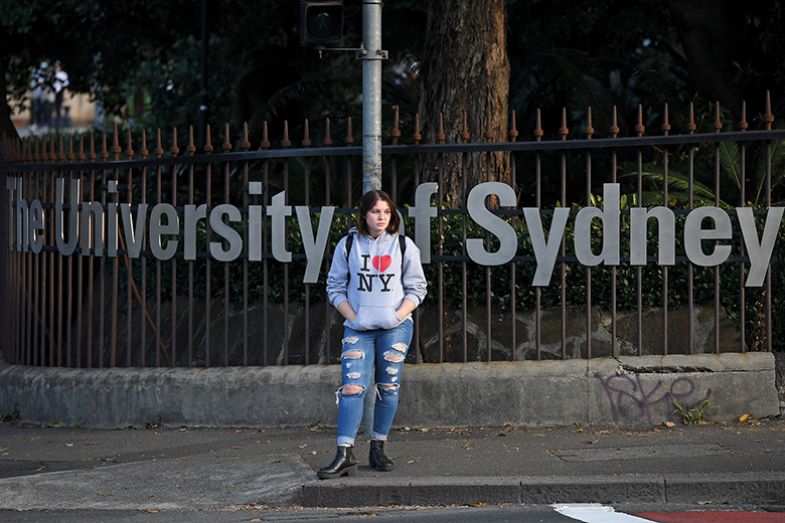
As Australia grapples with contradictory policies, circumstances are changing in its key student source markets. Honeywood says foreign graduates working in Australia as taxi drivers are increasingly deciding to return to India and “make good money” as information technology specialists.
“In Australia, [they have] to jump through all sorts of hoops [and] the cost of living is so high. As salaries [back home] become more appropriate for the qualifications they’ve attained in Australia, then they’re more likely to think twice about whether they want to stay.”
The situation in Australia’s other major market, China, is harder to interpret. Esaki-Smith says the allure of post-study work visas has been less compelling for students from China, partly because of their country’s increasingly competitive domestic jobs market. People who spend a few years working overseas “may be disqualified from entry-level job schemes in China, which are limited to recent university graduates”, she says. “They are then potentially thrust into a larger, more competitive pool of job applicants that include those with more work experience.”
Huang says degrees from top-branded institutions are the main draw for students from his native China, as well as for those from his adopted home, Japan: “If you graduate…from a university ranked among the top 100, you do not have to worry about your employment in China or Japan.”
But Melbourne policy analyst Angela Lehmann says China’s record youth unemployment could shake things up, encouraging young Chinese to look overseas not just for work experience but for permanent homes.
Lehmann, now head of research with international education consultants The Lygon Group, is a former assistant professor at Xiamen University in southern China. She says the relationship between education and migration has long been the unacknowledged “elephant in the room” in Australia. “Right now, for the first time [in] a long time, we can have that conversation, she says.
“And we need to have that conversation, because we are facing dire skills gaps in Australia. We have an international education sector that produces Australia-friendly, Australia-ready skilled workforces. The conversation is there to be had.”
Register to continue
Why register?
- Registration is free and only takes a moment
- Once registered, you can read 3 articles a month
- Sign up for our newsletter
Subscribe
Or subscribe for unlimited access to:
- Unlimited access to news, views, insights & reviews
- Digital editions
- Digital access to THE’s university and college rankings analysis
Already registered or a current subscriber? Login








